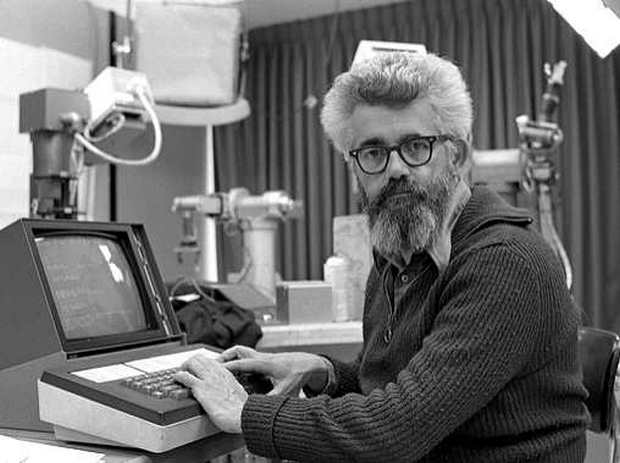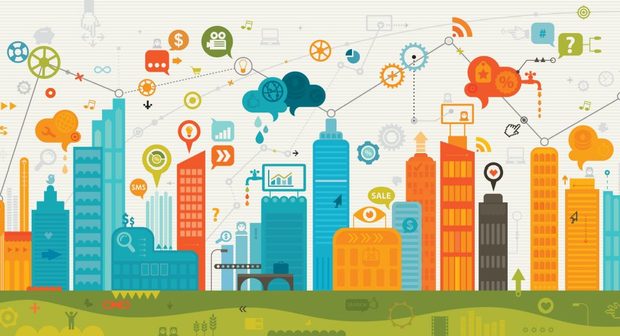Rustem Dautov’s lecture: economy of collaborative consumption as technology development vector
Rustem Dautov tells what technology will replace cloud computing
Rustem Dautov, research associate at Higher School of Information Technology and Information Systems of the Kazan Federal University, gave a lecture in the university where he told about an alternative to cloud-based technologies, about how suspicious persons are identified using cameras in a student campus, and about the near future with unmanned vehicles. Read the details in the material of Realnoe Vremya.
What is instead of clouds
At the beginning of the lecture, Rustem Dautov noted that the world was shifting from cloud computing to the model of sharing computing. It is this area being studied by the expert as part of a team of scientists. He elaborated on the development of cloud computing, the idea of which in 1961 was voiced by Professor John McCarthy. He stated that computer resources should be provided similarly as electricity, water, gas and other utilities.
Over 60 years, information technologies have made the transition from the mainframe in the 1960s to the era of cloud computing in 2010. Now IT in some way or another is connected with cloud computing. There are basic cloud delivery models, various deployment models. For example, in the university it is possible to run a private cloud, access to which will have only the students and teachers. The access to public clouds of Amazon, Google is available to any user.
The clouds have evolved to unprecedented level: every cloud service by its computing power exceeds all computing resources that the KFU has, Rustem Dautov claims. However, cloud resources also have some disadvantages. It is not always fast to work with them, there are security issues, and they are not cheap.
''Our research group is working on the main problem — the connection between the end device and the cloud. We wondered: what if it is possible to minimize network traffic and not to send data to the cloud through the Network but to develop them in the immediate vicinity of the source? You may say: but local resources are not enough to process the information. That is why the cloud was invented, they have huge capacities that end devices do not have — phones, laptops. We decided that this sharing computing will help us in this,'' Dautov said.

Using but not possessing
The basic idea of sharing computing is that such model allows to process and store data locally between devices.
''There are about 100 people in the audience. Everyone has a cell phone that has 3 gigabytes of memory and a powerful processor, and if they all are combined, we will get a powerful resource that can and should be used. Your phones just lie there and nobody use them, although their resources can be combined to solve any problem,'' the scientist said.
Based on data from Wikipedia, сollaborative consumption is based on the idea that sometimes it's easier to pay for temporary access to a product than to own it. For example, trading platforms based on models of collaborative consumption allow you to share skills, goods, services and money. Rustem Dautov told about several services to illustrate the idea of collaborative consumption. Airbnb is an online platform for posting, searching and short-term rental of private housing around the world. Through this service it is possible to rent an apartment if a person goes somewhere for the whole summer, for example. Uber allows you to rent out your vehicles. On Cookisto website, any hostess can post culinary masterpieces and invite guests to lunch together.
It is also possible to do voluntary computing through sharing computing. The website Rosettа@home does that. The major project appeared in the 1990s and still continues. Each person could download the app that at nights, when people do not use their computers, analyzed the cosmic noise. Thus the program was looking for a pattern or sequence that would prove the existence of extraterrestrial life.
Using volunteer computing it is possible to recognize patterns of wild nature, to decipher DNA, protein chains. Everyone makes their own pieces and combine it in the end. The next project that uses collaborative computing is called crowdsourcing. One of the examples is Wikipedia, when the encyclopedia is made by people from different corners of the Earth. There is a concept close to crowdsourcing – crowdsensing. ''In fact, it's the same as crowdsourcing. Only instead of new skills people share information that comes with their mobile devices. Every morning I do crowdsensing when I look out the window and think how many people have taken an umbrella,'' Rustem Dautov gave an example.
The service Strava also can be attributed to crowdsensing. You can add your GPS in the app. The service is actively used by runners, cyclists to record their workouts, track their progress, chat with like-minded people. The Waze app allows you to monitor the situation on roads in real time, to calculate the best routes, learn about the location of speed radars, to obtain information and to warn other users about changes in road conditions, obstacles, etc.

''Smart'' cities will follow sharing computing
Rustem Dautov turned from the topic of collaborative computing to the Internet of things. In his words, ''smart'' device in the context of the Internet of things is a device equipped with processing power, microprocessor, interface, sensors to collect information in the environment. In 2016, these devices were 23 billion, by 2020 their number will increase to 50 billion. The year 2008 is when the Internet of things appeared, when connected devices became more than the world's population.
Rustem Dautov explained that the Internet of things exists because of M2M interaction. These technologies allow machines to communicate directly without human participation. Here is a classic example: the car goes along California and exchanges information with phones, barriers, pedestrians.
P2P networks also influence collaborative computing.
''At the beginning of the lecture I mentioned that client-server model is the established model. Such network has one disadvantage: if the central server collapses, the data exchange will stop. The P2P network eliminates this disadvantage, all nodes are connected to each other. The system is more reliable, and in this case, there is no need to call the cloud. Data exchange can be arranged between the end devices directly,'' the scientist says.
He comes to the conclusion that the future of IT industry is in the economy of collaborative consumption, that is, in development of the Internet of things, crowdsourcing, crowdsensing. The collaborative computing involves the exchange of data between the endpoints without transmitting the data through external, possibly insecure, overloaded communication channel, as well as access and sharing of common computing resources for the solution of any tasks.
''We want the computing and data storage are carried out directly between endpoints without a central component. It will lead to increased performance and eliminate the need of data transmission through possibly insecure communication channel,'' Rustem Dautov considers.

The Internet of things does not need human
One of the projects of the Higher School of Information Technologies and Information Systems of the KFU — detection of suspicious persons in campus with cameras — can also be attributed to the Internet of things.
''We have one camera, which in itself cannot recognize faces. We connected a lot of microcomputers to it. Microblosks are distributed among the devices, which do face detection. If there is a crowd, then we connect an additional security camera,'' Rustem Dautov explains the project concept.
He sees development of the Internet of things in creation of unmanned vehicles in the future, when vehicles can communicate with each other, with road infrastructure. The scientist makes plans for the future, stating that ''smart'' urban spaces, ''smart'' offices, warehouses, factories await the world.
''You can ask me about security. Yes, there is such aspect. But collaborative computing is based on voluntary participation. We are not going to destroy the cloud industry. We are just working on sharing computing,'' the scientists reassured the audience.